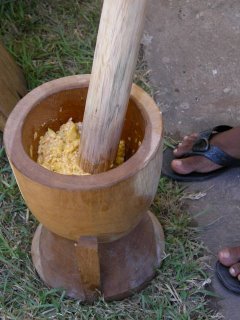Food Science of African Tastes: comminution and the asanka
 Anyone familiar with African cuisines knows that grinding and pounding are important cooking techniques, and texture matters. She or he also knows that while an electric blender is a lot faster and easier than a mortar and pestle or a grinding stone or bowl, it comes at a cost: a deterioration of flavor.
Anyone familiar with African cuisines knows that grinding and pounding are important cooking techniques, and texture matters. She or he also knows that while an electric blender is a lot faster and easier than a mortar and pestle or a grinding stone or bowl, it comes at a cost: a deterioration of flavor.Prof. Sefa-Dedeh, Professor of Food Science and Technology, and Dean of the Faculty of Engineering Sciences at the University of Ghana, talked to me about why these taste differences occur.
I asked why a blender gives such different results, than say, the Ghanaian asanka pictured above. Asankas are ubiquitous in Ghanaian kitchens: they are clay grinding/mashing bowls with ridged surfaces and are used with a wooden masher. I keep several in my Pennsylvania kitchen, especially for making fresh pepper sauces.
He explained to me that there are several reasons for the differences and began by mentioning there are "attrition" and "impact" forces. First, you begin with a solid material like ginger or tomato or chili peppers or garden eggs (similar to a small eggplant), cooked or uncooked, which you want to shred. Each ingredient has cells in it with a structure, and in the cells are all the taste and flavors. For example, when you break a piece of ginger you begin to smell it because you have broken down the cells and some of the compounds begin to interact.
When you use an asanka as your "size reduction equipment," the amount of force you apply to the ingredients is much less than you get from a blender. With something like a pepper, you generally don't want a lot of impact, you're more interested in shearing and tearing the structure, but not completely. In the blender you are "comminuting" (pulverizing) all the ingredients together so you may actually lose some of the flavor. Ghana's traditional mashing bowl conserves the flavor because of the way it separates the particles.
Finally, when you eat a product, different particle sizes will likely give different tastes even though the ingredients may be the same. For example, some people may cook a soup with a whole pepper in it. If you're eating the soup and you bite into certain peppers, a single bite of the pepper releases the compounds that interact with your tongue and palate and gives you a certain sensation in your mouth (the flavor chemistry).

So, the differences are partly due to the equipment used for the size reduction to give you a certain product. When you put that product in your mouth a certain reaction takes place. To summarize, when you put food into a blender to blend it you have virtually broken all the tissues into one mass, and the effect in your mouth is not the same as when you pound or mash the ingredients.
I guess I intuitively knew this, but still it was nice to have Prof. Sefa-Dedeh explain it. Soon I'll share his insight about fermentation and answer to my question about why I have not yet succeeded in souring dried corn to make an authentic corn dough for Ghanaian-style kenkey.
Footnote: Last week I mentioned that BETUMIBlog had been selected as one of the "100 Best Blogs for Learning About Africa." This week I was informed that it is on another list: this time as one of the "Top 50 Blogs for Studying Africa." I'm not sure who "University Reviews Online" actually is, but thought I'd mention it for what it's worth.
Labels: african food science, asanka, sefa-dedeh


4 Comments:
Hi Fran
I just happened to find your blog while searching for a mafe recipe. This blog entry explains scientificially something I have always known but could not explain. I am from Barbados and my food inspiration is my second cousin Winnie who cooked for me when I was a child. She used a mortar and pestle to make the Bajan green seasoning that is our season base and the food was full of flavour. I find that blending the same herbs does not give the same complex multilayered flavour and in fact can have a slightly bitter taste. Thanks for the explanation.
C
Fascinating post - same as Mangobelle above, I've always known but never been able to explain (other than saying "it's just better the Ghanaian way.."!) and now, thanks to you, I'll be able to "impress" family and friends with my newly acquired knowledge..!!!!
It's always fun visiting your blog and I always learn something new - thanks..:)
Thank you to both of you (MangoBelle and "me, myself, I" for your support and kind remarks. It's always an encouragement to hear from folks reading the blog, and to know that it is useful.
Hello,
I was wondering if you know where I can buy an asanka! The blender just doesn't do as well~ Thank you!
Post a Comment
<< Home